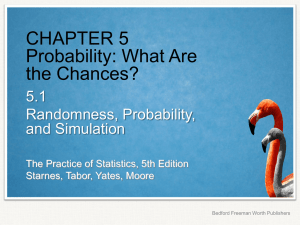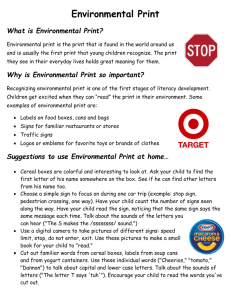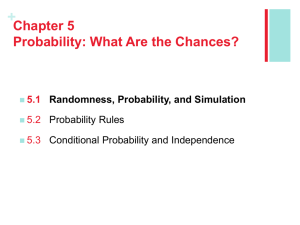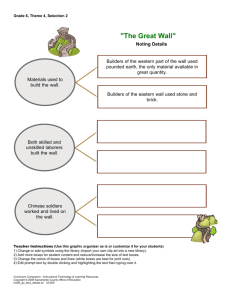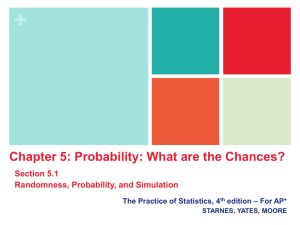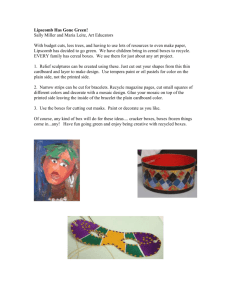AP Stats Chap 5.1
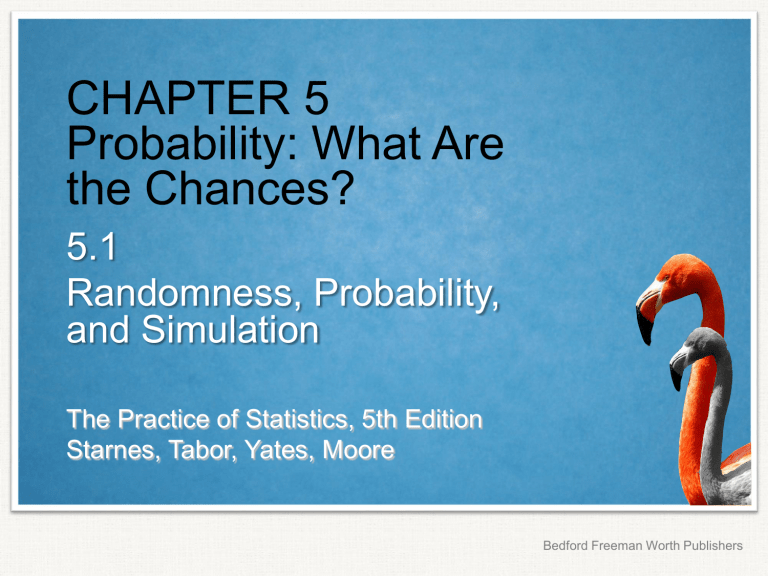
CHAPTER 5
Probability: What Are the Chances?
5.1
Randomness, Probability, and Simulation
The Practice of Statistics, 5th Edition
Starnes, Tabor, Yates, Moore
Bedford Freeman Worth Publishers
Randomness, Probability, and Simulation
Learning Objectives
After this section, you should be able to:
INTERPRET probability as a long-run relative frequency.
USE simulation to MODEL chance behavior.
The Practice of Statistics, 5 th Edition 2
The Idea of Probability
Chance behavior is unpredictable in the short run, but has a regular and predictable pattern in the long run.
The law of large numbers says that if we observe more and more repetitions of any chance process, the proportion of times that a specific outcome occurs approaches a single value.
The probability of any outcome of a chance process is a number between 0 and 1 that describes the proportion of times the outcome would occur in a very long series of repetitions.
The Practice of Statistics, 5 th Edition 3
Myths About Randomness
The idea of probability seems straightforward. However, there are several myths of chance behavior we must address.
The myth of short-run regularity:
The idea of probability is that randomness is predictable in the long run . Our intuition tries to tell us random phenomena should also be predictable in the short run. However, probability does not allow us to make short-run predictions.
The myth of the “ law of averages ” :
Probability tells us random behavior evens out in the long run. Future outcomes are not affected by past behavior. That is, past outcomes do not influence the likelihood of individual outcomes occurring in the future.
The Practice of Statistics, 5 th Edition 4
Simulation
The imitation of chance behavior, based on a model that accurately reflects the situation, is called a simulation .
Performing a Simulation
State : Ask a question of interest about some chance process.
Plan : Describe how to use a chance device to imitate one repetition of the process. Tell what you will record at the end of each repetition.
Do : Perform many repetitions of the simulation.
Conclude : Use the results of your simulation to answer the question of interest.
We can use physical devices, random numbers (e.g. Table D), and technology to perform simulations.
The Practice of Statistics, 5 th Edition 5
Example: Simulations with technology
In an attempt to increase sales, a breakfast cereal company decides to offer a NASCAR promotion. Each box of cereal will contain a collectible card featuring one of these NASCAR drivers: Jeff Gordon, Dale
Earnhardt, Jr., Tony Stewart, Danica Patrick, or Jimmie Johnson.
The company says that each of the 5 cards is equally likely to appear in any box of cereal.
A NASCAR fan decides to keep buying boxes of the cereal until she has all 5 drivers’ cards. She is surprised when it takes her 23 boxes to get the full set of cards. Should she be surprised?
Problem : What is the probability that it will take 23 or more boxes to get a full set of 5 NASCAR collectible cards?
The Practice of Statistics, 5 th Edition 6
Example: Simulations with technology
Plan : We need five numbers to represent the five possible cards.
Let’s let 1 = Jeff Gordon,
2 = Dale Earnhardt, Jr.,
3 = Tony Stewart,
4 = Danica Patrick, and
5 = Jimmie Johnson.
We’ll use randInt(1,5) to simulate buying one box of cereal and looking at which card is inside.
Because we want a full set of cards, we’ll keep pressing Enter until we get all five of the labels from 1 to 5. We’ll record the number of boxes that we had to open.
The Practice of Statistics, 5 th Edition 7
Example: Simulations with technology
3 5 2 1 5 2 3 5 4 9 boxes
5 1 2 5 1 4 1 4 1 2 2 2 4 4 5 3 16 boxes
5 5 5 2 4 1 2 1 5 3 10 boxes
4 3 5 3 5 1 1 1 5 3 1 5 4 5 2 15 boxes
3 3 2 2 1 2 4 3 3 4 2 2 3 3 3 2 3 3 4 2 2 5
22 boxes
Conclude : We never had to buy more than 22 boxes to get the full set of
NASCAR drivers’ cards in 50 repetitions of our simulation. So our estimate of the probability that it takes 23 or more boxes to get a full set is roughly
0. The NASCAR fan should be surprised about how many boxes she had to buy.
The Practice of Statistics, 5 th Edition 8
Randomness, Probability, and Simulation
Section Summary
In this section, we learned how to…
INTERPRET probability as a long-run relative frequency.
USE simulation to MODEL chance behavior.
The Practice of Statistics, 5 th Edition 9
